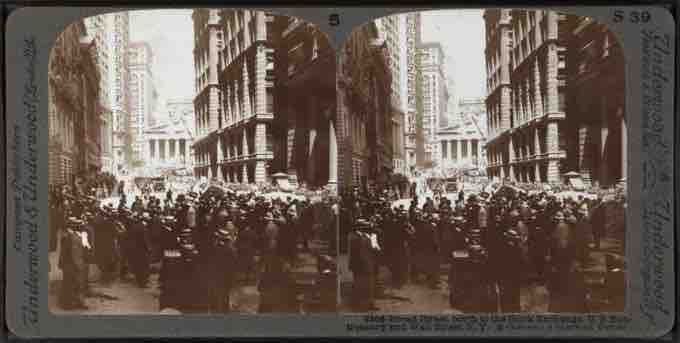Reasons to Repurchase Stock
The reasons to repurchase stock can vary from company to company. Reasons can include: (1) to cancel and retire the stock; (2) to reissue the stock later at a higher price; (3) to reduce the number of shares outstanding and increase earnings per share (EPS); or (4) to issue the stock to employees. The company either retires the repurchased shares or keeps them as treasury stock, available for re-issuance. If the intent of stock reacquisition is cancellation and retirement, the treasury shares exist only until they are retired and cancelled by a formal reduction of corporate capital. For accounting purposes, treasury shares are included in calculations to determine legal capital, but are excluded from calculations for EPS amounts.
.

Wall Street circa 1910
Public companies sometimes repurchase their own stock. The reacquired stock is referred to as treasury stock.
Benefits to Repurchasing Stock
Stock repurchases are often used as a tax-efficient method to put cash into shareholders' hands, rather than paying dividends. Sometimes, companies do this when they feel that their stock is undervalued on the open market. Another motive for stock repurchase is to protect the company against a takeover threat.
In an efficient market, the net effect of a stock repurchase does not change the value of each share. For example, if the market fairly prices a company's shares at $50 a share, and the company buys back 100 shares for $5,000, it now has $5,000 less cash but there are also 100 fewer shares outstanding. So, the net effect of the repurchase would be zero. Buying back shares can improve a company's price earnings ratio due to the reduced number of shares (and unchanged earnings). It can improve EPS due to the fewer number of shares outstanding as well as unchanged earnings. In an inefficient market that has underpriced a company's stock, a repurchase of shares can benefit current shareholders by providing support to the stock price. If the stock is overpriced, the opposite is true.
Accounting for Repurchased Shares
On the balance sheet, treasury stock is listed under shareholders' equity as a negative number. The accounts may be called "Treasury stock" or "equity reduction".
One way of accounting for treasury stock is with the cost method. In this method, the paid-in capital account is reduced in the balance sheet when the treasury stock is bought. When the treasury stock is sold back on the open market, the paid-in capital is either debited or credited if it is sold for more or less than the initial cost respectively.
Another common way for accounting for treasury stock is the par value method. In the par value method, when the stock is purchased back from the market, the books will reflect the action as a retirement of the shares. Therefore, common stock is debited and treasury stock is credited. However, when the treasury stock is resold back to the market, the entry in the books will be the same as the cost method.
In either method, any transaction involving treasury stock cannot increase the amount of retained earnings. If the treasury stock is sold for more than cost, then the paid-in capital treasury stock is the account that is increased, not retained earnings. In auditing financial statements, it is a common practice to check for this error to detect possible attempts to "cook the books. "
Example
Consider a company that repurchases 15,000 shares of its $1 par value stock for $25 per share. In this transaction:
- Treasury stock is debited $375,000
- Cash is credited $375,000
The firm then resells 7,500 shares of treasury stock for $28. In this transaction:
- Cash is debited $210,000
- Treasure Stock is credited $187,500
- Additional Paid-In Capital is credited $22,500
If the remaining 7,500 shares of stock are resold for less than the original $25 purchase price, and if the adjustment to treasury stock minus the proceeds from the sale is more than the balance of additional paid-in capital, an adjustment to retained earnings must be made. Consider the shares are sold for $21. The accounting for the transaction would be:
- Cash is debited $157,500
- Additional Paid-In Capital is debited $22,500
- Retained Earnings debited $7,500
- Treasury Stock is credited $187,500